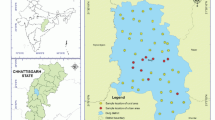Abstract
People are generally exposed to the natural radiation that presents inside and outside the houses. This investigation has been carried out gamma dose rate of 52 areas of Balod district, Chhattisgarh India. The values of outdoor and indoor gamma dose rates observed were 103.0 ± 3.1 to 201.0 ± 6.0 and 132.0 ± 4.0 to 260.0 ± 7.8 nSv/h, respectively. Indoor to outdoor gamma dose ratio was found to be 1.37. Total average annual effective dose value found to be slightly higher than the world population weighted average. Excess lifetime cancer risk was found to be 5.0 × 10−3 to 5.2 × 10−3 for a few places.





Similar content being viewed by others
References
UNSCEAR (United Nation Scientific Committee on the effect of Atomic Radiations) (2000) Ionizing radiation. Sources and biological effects report to the general assembly with scientific annexes. New York, United Nations
Sulekha RN, Kajori P, Hiroaki K, Sengupta D (2015) Measurement of environmental external gamma radiation dose rate outside the dwellings of southern coastal Odisha, eastern India. Curr Sci 109(3):600
Taskin H, Karavus M, Ay P, Topuzoglu HS, Karahan G (2009) Radionuclide concentrations in soil and lifetime cancer risk due to gamma radioactivity in Kirklareli, Turkey. J Environ Radioact 100:49–53
Kobya Y, Taskın H, Yesilkanat CM, Cevik U (2015) Evaluation of Outdoor Gamma Dose Rate and Cancer Risk in Artvin Province, Turkey. Hum Ecol Risk Assess 21(8):2077–2085
Avwiri GO, Nwaka BU, Ononugbo CP (2016) Radiological health risk due to gamma dose rates around Okposi Okwu and Uburu Salt Lakes, Ebonyi state. Int J Emerg Res Manag Technol 5(9):18–30
Tripathi RM, Sahoo SK, Mohapatra S, Patra AC, Lenka P, Dubey JS, Jha VN, Puranik VD (2012) An Assessment of the Radiological scenario around uranium mines in Singhbhum East district, Jharkhand, India. Radiat Protect Dosim 150(4):458–464. https://doi.org/10.1093/rpd/ncr431
Sadegh H, Naghizadeh BA, Hadi S, Manouchehr B, Sahar Z, Soheila R (2012) Investigation of natural effective gamma dose rates case study: Ardebil Province in Iran. Iran J Environ Health Sci Eng. https://doi.org/10.1186/1735-2746-9-1
Ononugbo CP, Avwiri GO, Ogan CA (2016) Natural radioactivity measurement and evaluation of radiological hazards in sediment of Imo River, in rivers state, Nigeria by gamma ray spectrometry. J Appl Phys 8(3):75–83
Tripathi RM, Sahoo SK, Jha VN, Rajesh Kumar, Shukla AK, Puraniki VD, Kushwaha HS (2011) Radiation dose to members of public residing around uranium mining complex, Jadguda, Jharkhand, India. Radiat Protect Dosim 147(4):565–572. https://doi.org/10.1093/rpd/ncq496
Ahmed RK (2012) Measurement the average gamma rate radiation for some regions in Baghdad city. J Kufa-Phys 4(1):48–55
Muhammad R, Ur RS, Muhammad B, Wajid A, Iftikhar A, Lone AK, Ahmed MK (2014) Evaluation of excess life time cancer risk from gamma dose rates in Jhelum valley. J Radiat Res Appl Sci 7:29–35. https://doi.org/10.1016/j.jrras.2013.11.005
Karunakara N, Yashodhara I, Kumara K, Sudeep, Tripathi RM, Menon SN, Kadam S, Chougaonkar MP (2014) Assessment of ambient gamma dose rate around a prospective uranium mining area of South India-A comparative study of dose by direct methods and soil radioactivity measurements. Results Phys 4:20–27. https://doi.org/10.1016/j.rinp.2014.02.001
UNSCEAR (United Nation Scientific Committee on the effect of Atomic Radiations) (1993) Sources and effects of ionizing radiation. UNSCEAR, New York
Prerna S, Kumar MP, Prasad MK (2014) Terrestrial gamma radiation dose measurement and health hazard along river Alaknanda and Ganges in India. J Radiat Res Appl Sci 7(4):595–600
Bagher TM, Ehsan K, Zahra S (2012) Assessment of gamma-dose rate in city of Kermanshah. J Educ Health Promot 1:1–4. https://doi.org/10.4103/2277-9531.100159
Ononugbo CP, Avwiri GO, Tutumeni G (2015) Estimation of indoor and outdoor effective doses from gamma dose rates of residential buildings in Emelogu village in Rivers State, Nigeria. Int Res J Pure Appl Phys 3(2):18–27
Jwanbot DI, Izam MM, Nyam GG, Yusuf M (2014) Indoor and outdoor gamma dose rate exposure levels in major commercial building materials distribution outlets in Jos, plateau State-Nigeria. Asian Rev Environ Earth Sci 1(1):5–7
Mahmoud PA, Mahdi A, Iraj N, Majid A (2014) Annual effective dose from environmental gamma radiation in Bushehr city. J Environ Health Sci Eng. https://doi.org/10.1186/2052-336X-12-4
Ezekiel AO (2017) Assessment of excess lifetime cancer risk from gamma radiation levels in Effurun and Warri city of Delta state, Nigeria. J Taibah Univ Sci 11:367–380. https://doi.org/10.1016/j.jtusci.2016.03.007
Monica S, Prasad Visnu AK, Soniya SR, Jojo PJ (2017) Ambient gamma levels in the in seaside regions of Alapuzha district, Kerala. Int J Pure Appl Phys 13:179–187
Asere AM, Ajayi IR (2017) Estimation of outdoor gamma dose rates and lifetime cancer risk in Akoko Region, Ondo state, Southwestern Nigeria. J Environ Sci Toxicol Food Technol 11(5):49–52. https://doi.org/10.9790/2402-1105024952
Balod District Administration. Government of Chhattisgarh. http://balod.gov.in/en
Census Data, Meta Data (2011) Ministry of Home Affair, Government of India. http://www.censusindia.gov.in
NRC (National Research Council) (2006) Health risk from exposure to low levels of ionizing radiation: BEIR VII PHASE 2. The National Academies Press, Washington, DC
Radiation Risk in Perspective (2016) Position statement of the Heath Physics Society
Sar SK, Diwan V, Biswas S, Singh S, Sahu M, Jindal MK, Arora A (2017) Study of uranium level in groundwater of Balod District of Chhattisgarh State, India and assessment of health risk. Hum Ecol Risk Assess. https://doi.org/10.1080/10807039.2017.1397498
Acknowledgements
We are thankful to the Board of Research in Nuclear Sciences (BRNS), Department of Atomic Energy, Government of India for funding the project 36(4)/14/90/2014-BRNS. The authors are also thankful to Bhilai Institute of Technology for providing the facilities.
Author information
Authors and Affiliations
Corresponding author
Rights and permissions
About this article
Cite this article
Jindal, M.K., Sar, S.K., Singh, S. et al. Risk assessment from gamma dose rate in Balod District of Chhattisgarh, India. J Radioanal Nucl Chem 317, 387–395 (2018). https://doi.org/10.1007/s10967-018-5846-9
Received:
Published:
Issue Date:
DOI: https://doi.org/10.1007/s10967-018-5846-9




